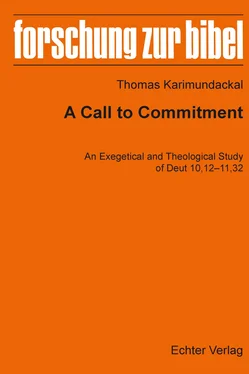1 ...8 9 10 12 13 14 ...20 Most of the variants of the Smr from MT are characterized either by features of orthographical and grammatical change or by expansion based on parallel passages or by the addition of certain Samaritan words to highlight its ideology. 136
3.3.1 Harmonizing alterations
Most of the variant readings in Smr show a certain harmonizing tendency to remove contradictions in the text. 137This is done mostly by synchronizing the text with another biblical passage.
• In 10,13a the Smr adds אלהיך to create the expected formula “the Lord your God” (cf. 4,2; 6,17; 8,6; 11,27.28; 28,9.13).
• In 11,1b the Smr follows the sequence of וחקתיו ומצותיו ומשׁפטיו (cf. 8,11; 26,17; 30,16) in contrast to MT’s ושׁמרת משׁמרתו וחקתיו.
• In 11,6a the Smr adds ואת כל־האדם אשׁר לקרח along with ולאבירם לדתן as in Num 16,32.
• In 11,8f the Smr has באים שׁמה (cf. 4,5; 30,18) instead of עברים שׁמה (cf. 4,14; 6,1; 11,11).
• In 11,17e the Smr reads מהר in place of מהרה as in the case of 4,26; 7,4; 9,3; 12,16 and 28,20.
• In 11,18b the Smr has ידיכם instead of the singular ידכם in tune with 6,6-9.
• In 11,19c the Smr reads בבית instead of בביתך corresponding to 6,7.
• In 11,22a the Smr adds היום to מצוה אתכם as in v13.27.28.
• In 11,25a the Smr reads לפניכם instead of בפניכם as in the case of 9,2; 7,24; 11,26b.32c.
• In 11,30b the Smr reads singular אלון מורה as in Gen 12,6 instead of the MT’s אלוני מרה.
• In 11,32b the Smr adds כל before המשׁפטים to harmonize with the preceding phrase את כל־החקים.
3.3.2 Alterations related to content and ideology
Some of the readings of the Smr differ from the MT with regard to their content and the theological concerns of the Samaritan community. For example:
• The addition of מול שׁכם in 11,30b reflects the Samaritans belief that Shechem is the chosen place of worship. 138
3.3.3 Linguistic corrections
The Smr tends to adopt a more formal conception of the grammar, as if correcting the inconsistencies in the text. 139
• The Smr corrects the non-agreement of the predicate with the subject in number and gender: In 10,22a the Smr reads אבות instead of אבתיך in the MT. In 11,10b the singular אתה בא is treated as plural in the Smr אתם באים. In 11,10f the idiom והשׁקית ברגלך is changed into the plural 140.והשׁקית ברגליך In 11,20 the singular ביתך is changed into the plural בתיך in the Smr. In 11,14a the Smr has ארצך instead of the MT’s ארצכם. In 11,23 the Smr reads מלפניך instead of the MT’s מלפניכם. In 11,8b instead of the MT’s מצוך the Smr has מצוה אתכם.
• In 10,17b the Smr uses the singular האדון instead of the MT’s ואדני so that the phrase becomes grammatically correct (“the Lord of the lords” vs “the Lords of the lords”).
• In 11,14-15 the Smr has removed the inconsistency of the narration by substituting the 3 rdperson throughout (ונתן v14a.15a) instead of the 1 stperson in the MT (ונתתי v14a.15a).
• The presence and absence of the definite article with שׁנה in 11,12b is corrected in the Smr by placing the definite article in both instances.
• In certain cases the Smr tends to add the conjunction ו in order to connect it to the preceding verse or phrases (10,13 לשׁמר → ולשׁמרa; והגבור → 10,17 הגברc; 11,2 את־ידו → ואת ידוe; מן־הנהר → ומן־הנהר 11,24c).
3.3.4 Orthographical changes
Some of the variant readings of the Smr confirm the orthographical pattern of the Smr. 141
• In certain cases a ו is used to mark o in the Smr: האדנים → האדונים, והגבור → 10,17 הגברc; 10,17 הגדל → הגדולc; 11,7 הראת → הראותa; 11,18 לטוטפת → לטטפותc; 11,31 לבא → לבואb.
• In certain cases א is used to mark e in the Smr: מרשׁית → מראשׁית 11,12b and in certain cases ה is replaced by 11,14 יורה → יורא) אb).
• In some cases the Smr uses the short form in place of the MT’s longer form (17 מהרה → מהרe; 11,30 המה → הםa).
3.3.5 Alterations by the omission of words
Some of the variant readings of the Smr occur as a result of the omission of certain words. For example:
• In 11,9c the Smr leaves out להם of the MT. In 11,3b the Smr skips the explanatory gloss מלך־מצרים of the MT.
Summary: Although the Smr differs from the MT in a number of details, the Smr bears a close relationship to the MT. Most of the significant variations are in tune with the harmonizing or interpreting tendency of the Smr or due to its morphological and orthographical features.
3.4 Observations on the MT and the LXX
The LXX frequently reproduces the MT by a literal rendering of their original, although it differs at times from the MT. 142The LXX contains a relatively large number of significant variants which bear on the literary criticism of the Old Testament. 143Though there is no common pattern for these variant readings, one can identify certain characteristics such as, harmonization, interpretation, additions, linguistic corrections etc.
3.4.1 Harmonizing alterations
One of the dominant features of the LXX’s variant readings is its harmonizing tendency, especially to harmonize the text with another biblical passage. 144
• The LXX never translates the bound phrase בארץ מצרים by the genitive but always by the dative ἐν γῇ Αἰγύπτῳ (10,19; cf. 5,15; 15,15; 24,22; 29,1.15; 34,11).
• The LXX routinely translates כל־המצוה with the plural form τὰς ἐντολὰς (11, 8a; cf. 6,25; 8,1; 15,5; 27,1).
• In 11,1b the LXX follows the sequence of וחקתיו ומצותיו ומשׁפטיו as in 8,11 (cf. 26,17; 30,16).
• In 11,3a the LXX has καὶ τὰ σημεῖα αὐτοῦ καὶ τὰ τέρατα αὐτοῦ instead of the MT’s ואת־אתתיו ואת־מעשׁיו to harmonize with the common pair as in 4,34; 6,22; 7,19; 26,8; 29,2 and 34,11. 145
• In 11,8c the LXX reads למען תחזקו as ἵνα ζῆτε καὶ πολυπλασιασθῆτε in conformity with 8,1 (למען תחיון ורביתם; cf 4,1; 16,20). The ἵνα clause with its four verbs is not a literal translation of the MT but a word for word repetition of 8,1 and it recalls the promise given to their ancestors.
• In 11,11b the LXX’s reading εἰσπορεύῃ instead of עברים is in tune with the preceding verse. 146
• 11,22a the LXX adds היום to מצוה אתכם as in 11,13.27.28.
• In 11,24c the LXX reads הנהר הגדול as in 1,7 (τοῦ ποταμοῦ τοῦ μεγάλου; cf. Gen 15,18; Josh 1,4). 147
• In 11,30b the LXX reads τῆς δρυὸς τῆς ὑψηλῆς as in Gen 12,6 instead of the MT’s אלוני מרה (cf. the note at 11,30b).
3.4.2 Theological interpretation
Another significant feature of the LXX’s variant readings is its theological concerns. Since the LXX reflects the theological interests of the translator, it gives insights into how the MT was understood and interpreted at the time of its translation. 148
• The figurative language of the MT in 10,6 is translated with a theological focus in the LXX. The LXX lacks a corresponding term for ערלת in 10,16a but it is translated by περιτεμεῖσθε τὴν σκληροκαρδίαν ὑμῶν, giving a moral interpretation to the foreskin.
• In 11,13-15 the LXX does not alter the sequence of narration, but synchronizes the first person references מצותי (my commandments) and ונתתי (I will give) with the third person references (τὰς ἐντολὰς αὐτοῦ and δώσει). In these references, the first person could hardly be Moses, rather it refers to God. Therefore, the LXX has changed all these to the third person references.
Читать дальше












